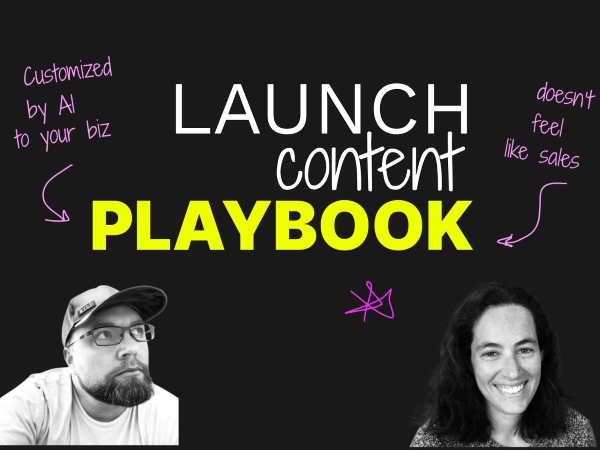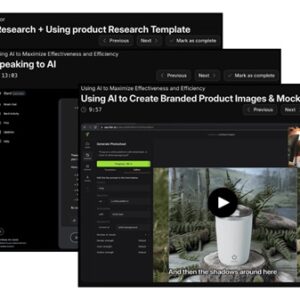[GroupBuy] Rob Lennon and Erica Schneider – The Launch Content Playbook
$449.00 Original price was: $449.00.$59.00Current price is: $59.00.
- Delivery: You Will Receive A Receipt With Download Link Through Email.
- If you need more proof ofcourse, feel free to chat with me!

Description
Table of Contents
ToggleIntroduction to the Launch Content Playbook
Launching a new product or service can be a daunting task, and the stakes are high. The success of a launch often hinges on how effectively you communicate your message, engage your audience, and deliver value through your content. The Launch Content Playbook serves as a comprehensive guide to help you navigate this complex process, ensuring that every piece of content supports your goals and resonates with your target audience.

This framework is designed to streamline your launch efforts, providing clarity and direction amidst the chaos. By following the principles laid out in the playbook, you can maximize impact and drive engagement throughout your launch campaign.
Understanding the Importance of Content in Launches
Content is more than just words on a page; it’s the lifeblood of your launch strategy. It has the power to educate, inspire, and persuade your audience. In a crowded marketplace, compelling content can differentiate your brand and create a meaningful connection with potential customers.
Effective content helps articulate your brand narrative, showcase your unique value proposition, and address the pain points of your audience. When executed correctly, it builds trust and establishes authority, paving the way for successful conversions during the launch phase.
Overview of the Launch Content Playbook Framework
The structure of the Launch Content Playbook is designed to cover all essential aspects of your launch campaign. From identifying your target audience to measuring success post-launch, each section aims to provide actionable insights and strategies.
By utilizing a mix of various content types—such as blog posts, social media updates, videos, and email campaigns—you’ll find a holistic approach to engage your audience effectively. This framework also emphasizes the importance of planning and adaptability, allowing you to respond to feedback and iterate on your content strategy as needed.
Defining Your Audience
Understanding who your audience is forms the foundation of any successful launch strategy. Identifying your target demographics allows you to tailor your messaging while addressing their specific needs and challenges.
Taking the time to research and define your audience will not only inform your content development but will also enhance your marketing effectiveness. By creating personas based on real data and insights, you can develop targeted strategies that resonate deeply with those you wish to reach.
Identifying Target Demographics
Identifying your target demographics involves delving into various factors like age, gender, location, interests, and buying behaviors. This segmentation enables you to create refined marketing messages that are relevant and appealing.
To gather this data, consider utilizing surveys, social media insights, and website analytics. Additionally, competitive analysis can reveal gaps in the market and inform your understanding of who your audience is and what they truly value.
Understanding Audience Pain Points and Needs
Beyond basic demographics, it’s crucial to grasp the pain points and needs of your audience. What challenges do they face that your product or service can solve? How can you present your offering as the solution they’ve been searching for?
Conducting interviews or focus groups can provide qualitative insights that numbers alone cannot reveal. By genuinely listening to your audience, you can craft tailored messaging that speaks directly to their needs and desires, setting the stage for a successful launch.
Crafting a Unique Value Proposition
A unique value proposition (UVP) articulates why your product or service is distinct from competitors. It’s the core message that captures your audience’s attention and encourages them to choose your offering over others in the market.
Crafting a compelling UVP is essential because it drives the entire narrative of your launch. From your marketing materials to your customer interactions, a clear UVP ensures that everyone is aligned with the same vision of your brand’s value.
What is a Unique Value Proposition?
At its essence, a unique value proposition communicates the unique benefits and features of your product that set it apart. It succinctly answers the question: “Why should I choose this product?”
Your UVP should highlight the specific problems your product solves, the unique features it offers, and the tangible benefits customers can expect. This clarity will enable you to position your offering confidently in the crowded market landscape.
How to Communicate Value Effectively
Effectively communicating your UVP requires strategic messaging techniques. Focus on clarity and brevity; your audience should instantly understand the value you provide without unnecessary jargon.
Utilizing storytelling can also enhance how you present your UVP. Sharing real-life customer testimonials or case studies can illustrate the benefits of your product in action, making your value proposition more relatable and impactful.
Developing a Content Strategy
A well-thought-out content strategy aligns your launch efforts with your business goals. It serves as a roadmap guiding your content creation, distribution, and measurement processes.
By integrating a solid content strategy into your launch plan, you ensure that every piece of content furthers your objectives and resonates with your audience. This alignment is crucial for maximizing the effectiveness of your launch campaign.
Components of an Effective Content Strategy
An effective content strategy encompasses various components, including audience research, content creation methodologies, distribution channels, and performance metrics. Each element plays a vital role in ensuring your launch is cohesive and impactful.
Additionally, it’s essential to determine your content themes and key messages early on. This foresight will help maintain a consistent tone and voice across all platforms, allowing your brand to become recognizable and trusted.
Aligning Content with Business Goals
Aligning your content with overarching business goals ensures that your launch contributes positively to your brand’s growth. Whether your aim is to increase sales, build brand awareness, or generate leads, your content must reflect these objectives.
Regularly revisiting your goals during the content development process allows for adaptations and pivots when necessary. This proactive approach minimizes wasted resources and maximizes the overall effectiveness of your launch campaign.
Types of Content for Launches
When it comes to launching a product, diversity in content types is vital. Different formats cater to varying audience preferences, making it essential to leverage multiple channels for maximum reach and engagement.
Incorporating various content types not only keeps your audience sustained in their interest but also enhances the overall experience of your launch. You can employ blogs, videos, social media campaigns, and email strategies to create a robust promotional ecosystem.
Blog Posts and Articles
Blog posts and articles serve as foundational pieces of long-form content that can delve deep into your product’s features, benefits, and unique selling points. These writings allow you to educate your audience extensively, positioning your brand as an authority in your industry.
SEO optimization is critical in this context. Incorporating relevant keywords related to your launch will improve visibility and organic traffic. Moreover, compelling headlines and strong calls-to-action can encourage readers to take the next step toward conversion.
Social Media Campaigns
Social media platforms offer unparalleled opportunities for engaging with your audience directly. Creating targeted campaigns that utilize eye-catching visuals and strong narratives can generate buzz around your launch.
Be sure to include interactive elements such as polls, Q&As, or contests. These tactics foster community involvement and increase excitement leading up to your launch. Monitoring social conversations in real-time can also provide valuable insights that inform ongoing content adjustments.
Video and Multimedia Content
Video provides an engaging medium that can showcase your product in action. Skillfully produced video content can convey emotion and intricately demonstrate how your product solves problems, making it an invaluable part of your launch strategy.
Moreover, multimedia content—such as infographics or animated explainers—can simplify complex information and make it digestible. As visual storytelling becomes increasingly popular, incorporating a variety of formats can significantly boost your content’s effectiveness.
Email Marketing Strategies
Email remains a powerful tool for direct communication with your audience. Crafting personalized and segmented email campaigns can nurture leads and keep interested individuals informed about your launch.
Consider creating a series of emails that progressively build anticipation. Early teasers, exclusive sneak peeks, and countdown reminders can keep your audience engaged and excited leading up to your launch day.
Planning Your Content Calendar
A content calendar is an invaluable tool that can help you organize your launch campaign and ensure timely execution. Planning your content in advance allows for better coordination among team members and helps maintain consistency across platforms.
Establishing milestones and deadlines is crucial for keeping your campaign on track. This level of organization minimizes stress and confusion as the launch approaches.
Setting Milestones and Deadlines
Milestones act as checkpoints in your content calendar, helping you track progress and assess readiness for the launch. Establishing significant dates—like content creation deadlines, review periods, and distribution schedules—ensures that your campaign runs smoothly.
Incorporate buffer periods in your timeline to account for any unforeseen delays. Being proactive in your planning can alleviate last-minute pressures and provide flexibility for creative adjustments if needed.
Balancing Promotional and Educational Content
Striking a balance between promotional and educational content is essential. While you’ll want to create excitement around your launch, providing valuable information is equally important to establish credibility and trust.
Aim to provide informative content that addresses audience pain points while subtly promoting your product. This balanced approach positions your brand as a thought leader while encouraging conversions organically.
Creating Compelling Content
Creating compelling content is at the heart of your launch strategy. Engaging copy and visuals that resonate with your audience can significantly impact their perception of your brand and willingness to make purchases.
Focusing on best practices for writing can elevate your content quality, while strong visuals complement and enhance your messaging.
Best Practices for Writing Engaging Copy
Engaging copy should be clear, concise, and persuasive. Start by understanding your audience’s language and preferences, then use relatable expressions and storytelling techniques to draw them in.
Incorporating a conversational tone makes your content feel more personal and approachable. Utilize strong hooks in your introductions to captivate readers and encourage them to continue consuming your content.
Incorporating Visuals to Enhance Content
Visual elements have the power to break up text and create an aesthetically pleasing reading experience. Infographics, images, and videos can support your written content by providing additional context and enhancing understanding.
Ensure that visuals are relevant to the content topic and reinforce your key messages. Using high-quality graphics and videos can significantly elevate the perceived value of your content, making it more likely to be shared and remembered.
Distribution Channels
Once your content is created, the next step is effectively distributing it across various channels. Knowing where your audience consumes content enables you to tailor your distribution strategy for maximum reach and engagement.
Identifying the right platforms and methods can significantly influence the success of your launch. Both organic and paid methods play important roles in ensuring your content reaches its intended audience.
Identifying Effective Platforms for Distribution
Different platforms cater to different demographics and content types. Understanding where your audience spends their time allows you to prioritize your distribution efforts accordingly.
For example, younger audiences may engage more with platforms like TikTok and Instagram, while professionals might prefer LinkedIn. Tailoring your content to fit the nuances of each platform ensures that your message is impactful and relevant.
Utilizing Paid vs. Organic Methods
While organic reach through social media and SEO can be effective, combining it with paid methods can exponentially enhance your content visibility. Paid advertising—such as social media ads, PPC campaigns, or sponsored content—can target specific user segments, ensuring your message gets in front of the right eyes.
Balancing both approaches allows for flexibility in your strategy. Testing various ad formats and targeting options can provide insights into what resonates best with your audience, enabling you to allocate resources efficiently.
Measuring Success
Measuring the success of your launch is crucial for determining the effectiveness of your content strategy and identifying areas for improvement. Key performance indicators (KPIs) provide valuable insights into how your audience interacts with your content.
Analyzing these metrics post-launch informs future content planning, helping you optimize your strategies and achieve greater results.
Key Performance Indicators to Track
Several KPIs can provide insights into your launch performance. Metrics such as website traffic, social media engagement, email open rates, and conversion rates give you a comprehensive view of your content’s impact.
It’s essential to set specific goals for each metric ahead of your launch. Regularly tracking these KPIs during and after the campaign will allow you to adjust your strategy in real time.
Analyzing Engagement and Conversion Rates
Engagement rates, such as likes, shares, comments, and click-through rates, indicate how well your content resonates with your audience. Higher engagement usually correlates with effective messaging and content relevance.
Conversion rates shed light on how many viewers took the desired action—be it signing up for a newsletter, downloading a resource, or making a purchase. Assessing these rates against your initial goals can lead to valuable lessons learned for future launches.
Adapting Based on Feedback
Feedback is an invaluable component of the content creation process. Understanding how your audience perceives your launch will help refine your strategies moving forward.
Iterative improvement based on feedback fosters a culture of continuous learning within your team. Utilizing analytics enhances your ability to make informed decisions regarding future content planning.
Importance of Iterative Improvement
Iterative improvement means continuously refining your strategies based on actual performance data and audience feedback. Each launch presents opportunities to learn about what worked, what didn’t, and how to adapt accordingly.
By embracing an agile mindset, you can experiment with different approaches and quickly pivot as needed. This flexibility positions your brand for long-term success as you continuously evolve with your audience’s needs.
Utilizing Analytics for Future Content Planning
Analytics tools can provide deep insights into user behavior, preferences, and engagement levels. By analyzing this data, you can identify trends that inform your future content strategy.
Monitoring the performance of various content types—such as video vs. blog posts—can help you allocate resources effectively. Tracking audience demographics can also reveal shifts in preferences, allowing you to stay ahead of the curve.
Case Studies and Examples
Examining case studies and examples of successful launches can offer tremendous insights into best practices and common pitfalls. Learning from those who have succeeded—and those who have stumbled—can shape your own strategies.
These real-world scenarios provide context and inspiration, illustrating how various components of the Launch Content Playbook come together for effective execution.
Successful Launches: Lessons Learned
Many brands have experienced remarkable success through well-executed launches. For instance, companies that fully embraced audience engagement and utilized pre-launch excitement saw enhanced customer loyalty and conversion rates.
Notable examples include the iPhone launches, which combined teasers, media coverage, and influencer partnerships to create a buzz that drove massive demand. Their understanding of consumer anticipation allowed them to maximize the impact of their launch content.
Common Mistakes to Avoid in Launch Content
On the flip side, there are numerous mistakes that brands can make during the launch process. Common pitfalls include poor audience identification, lack of clear messaging, and inadequate testing of content before distribution.
Failing to adapt to audience feedback or neglecting pre-launch marketing can diminish the effectiveness of even the most innovative products. Avoiding these mistakes requires diligent planning, audience understanding, and consistent evaluation of your strategies.
Building a Content Team
Creating a cohesive content team is crucial for executing your launch strategy effectively. Each team member brings unique strengths and skills that contribute to the overall success of the campaign.
Clearly defining roles and responsibilities ensures accountability and smooth collaboration across departments. By leveraging collaborative tools and resources, your team can work harmoniously towards a shared objective.
Roles and Responsibilities in Content Creation
When building your content team, define clear roles for each member, whether they are writers, designers, strategists, or analysts. Clearly designated responsibilities streamline the content creation process and minimize confusion.
Encouraging teamwork and collaboration fosters creativity and innovation. Regular check-ins and brainstorming sessions can help maintain alignment and generate new ideas for your launch content.
Collaborative Tools and Resources
Utilizing collaborative tools can enhance productivity and facilitate seamless communication among your team. Platforms like Slack, Trello, and Asana allow for efficient project management and real-time collaboration.
Investing in resources, such as graphic design software or content management systems, can further empower your team to produce high-quality content efficiently. Ensuring everyone has access to the right tools is essential for achieving your launch goals.
Leveraging Technology
Technology plays an integral role in optimizing your content creation, distribution, and measurement processes. From content management systems to automation tools, harnessing technology can significantly enhance efficiency and effectiveness.
Staying updated on the latest technological advancements allows your team to implement the best practices and strategies possible. Adopting the right tools will streamline workflows and free up time for creative brainstorming.
Content Management Systems
Content management systems (CMS) provide a centralized platform for managing, creating, and publishing content. A reliable CMS allows you to streamline your workflow, ensuring that all team members are on the same page.
Choosing a user-friendly CMS that integrates well with other tools in your tech stack can enhance productivity. The right system will support your content planning, version control, and collaboration efforts, ultimately contributing to a smoother launch process.
Automation Tools for Efficiency
Automation tools can save time and reduce manual work by handling repetitive tasks such as social media posting, email scheduling, and analytics tracking. Leveraging these tools allows your team to focus on more strategic initiatives.
Automating tasks like follow-ups and reminders ensures that deadlines are met, reducing the chances of missed opportunities during the hectic launch period. Embracing automation empowers your team to work smarter, not harder.
Staying Ahead of Trends
In a rapidly changing market landscape, staying ahead of industry trends is essential for maintaining a competitive edge. By keeping abreast of emerging trends, you can innovate and adapt your launch strategies to meet evolving consumer demands.
Periodic reassessment of your content and marketing strategies will ensure that you remain relevant and effective in your messaging.
Keeping Up with Industry Changes
Regularly consuming industry publications, attending conferences, and participating in webinars will heighten your awareness of new developments. Engaging with thought leaders and joining relevant online communities further expands your knowledge base.
Incorporating insights gained from these activities into your launch strategy can provide a fresh perspective and innovative ideas that keep your brand ahead of the curve.
Innovating for Future Launches
Innovation is key in differentiating your brand from competitors. Don’t shy away from experimenting with new content formats or distribution methods, especially those that align with current trends.
Trial and error can lead to breakthroughs that enhance your launch strategies. Encouraging a culture of creativity within your team fosters an environment where fresh ideas can flourish, leading to more successful future launches.
Conclusion: Putting It All Together
Harnessing the principles outlined in the Launch Content Playbook equips you with the tools necessary for creating a successful launch campaign. By meticulously defining your audience, crafting a unique value proposition, developing a thoughtful content strategy, and measuring success, you can effectively navigate the complexities of launching a product.
Remember that adaptability is key—staying open to feedback and iterating on your strategies will position you for ongoing success. By building a cohesive content team and leveraging technology, you can streamline your processes and maintain a competitive edge.
Ultimately, the integration of diverse content types and distribution channels will maximize your reach and engagement, paving the way for a successful launch. Embrace the journey, learn from the experiences, and let your creativity shine as you embark on this exciting endeavor.
Sales Page:_https://launchcontentplaybook.com/
Delivery time: 12 -24hrs after paid
Related products
-
Sale!

SMB – DNA Of Successful Trading
$5,000.00Original price was: $5,000.00.$49.00Current price is: $49.00. -
Sale!

[GroupBuy] Centerpointe – Secrets To Success And Making Money
$197.00Original price was: $197.00.$85.00Current price is: $85.00. -
Sale!

[GroupBuy] A.I. Revolution Bundle Faceless – A.I. Digital Creator Bundle
$197.00Original price was: $197.00.$19.00Current price is: $19.00. -
Sale!

Newsletter Mastery Course Alex Brogan
$997.00Original price was: $997.00.$25.00Current price is: $25.00.
Reviews
There are no reviews yet.